
Okazaki is a city located in Aichi Prefecture, Japan. As of 1 October 2019, the city had an estimated population of 386,999 in 164,087 households, and a population density of 999 persons per km². The total area of the city was 387.20 km2 (149.50 sq mi).

Anjō is a city in Aichi Prefecture, Japan. As of 1 October 2019, the city had an estimated population of 188,693 in 76,087 households, and a population density of 2,193 persons per km². The total area of the city was 86.05 square kilometres (33.22 sq mi).

Okazaki Castle is a Japanese castle located in Okazaki, Aichi Prefecture, Japan. At the end of the Edo period, Okazaki Castle was home to the Honda clan, daimyō of Okazaki Domain, but the castle is better known for its association with Tokugawa Ieyasu and the Tokugawa clan. The castle was also known as "Tatsu-jō " (龍城).
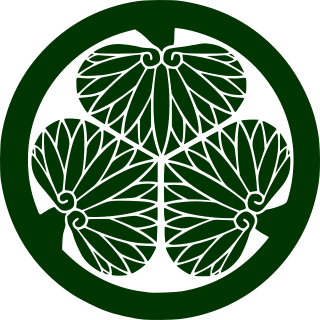
The Tokugawa clan is a Japanese dynasty which produced the Tokugawa shoguns who ruled Japan from 1603 to 1867 during the Edo period. It was formerly a powerful daimyō family. They nominally descended from Emperor Seiwa (850–880) and were a branch of the Minamoto clan through the Matsudaira clan. The early history of the clan remains a mystery. Nominally, the Matsudaira clan is said to be descended from the Nitta clan, a branch of the Minamoto clan, but the likelihood of this claim is considered quite low or untrue.

The Matsudaira clan was a Japanese samurai clan that descended from the Minamoto clan. It originated in and took its name from Matsudaira village, in Mikawa Province. During the Sengoku period, the chieftain of the main line of the Matsudaira clan, Matsudaira Motoyasu became a powerful regional daimyo under Oda Nobunaga and Toyotomi Hideyoshi and changed his name to Tokugawa Ieyasu. He subsequently seized power as the first shōgun of the Tokugawa shogunate which ruled Japan during the Edo period until the Meiji Restoration of 1868. Under the Tokugawa shogunate, many cadet branches of the clan retained the Matsudaira surname, and numerous new branches were formed in the decades after Ieyasu. Some of those branches were also of daimyō status.
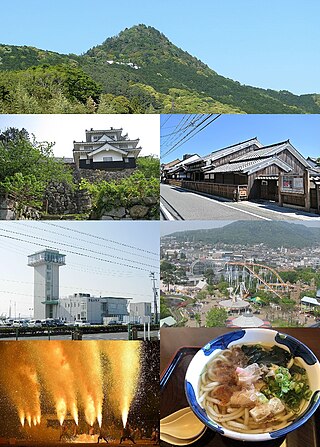
Toyohashi is a city in Aichi Prefecture, Japan. As of 1 December 2019, the city had an estimated population of 377,453 in 160,516 households and a population density of 1,400 persons per km2. The total area of the city was 261.86 square kilometres (101.10 sq mi). By area, Toyohashi was Aichi Prefecture's second-largest city until March 31, 2005 when it was surpassed by the city of Toyota, which had merged with six peripheral municipalities.

The Owari-Han, also known as the Owari Domain, was a significant feudal domain in Japan during the Edo period. Situated in the western region of what is now Aichi Prefecture, it covered portions of Owari, Mino, and Shinano provinces, with its central administration based at Nagoya Castle. At its zenith, the Owari Domain boasted an impressive rating of 619,500 koku, making it the largest landholding of the Tokugawa clan outside of the shogunal territories. The ruling clan of the Owari Domain was the Tokugawa clan, holding the prestigious position of the highest rank among the gosanke. Additionally, the domain was sometimes referred to as the Nagoya Domain due to its association with Nagoya Castle.

Kusatsu-juku was the fifty-second of the fifty-three stations of the Tōkaidō as well as the sixty-eighth of the sixty-nine stations of the Nakasendō. It is located in the downtown area of the present-day city of Kusatsu, Shiga Prefecture, Japan.

Kuwana-juku was the forty-second of the fifty-three stations (shukuba) of the Tōkaidō connecting Edo with Kyoto in Edo period Japan. It was located in former Ise Province in what is now part of the city of Kuwana, Mie Prefecture, Japan.

Hamada Domain was a feudal domain under the Tokugawa shogunate of Edo period Japan, in what is now western Shimane Prefecture. It was centered around Hamada Castle and was ruled by mostly a succession of fudai daimyō of various branches of the Matsudaira clan. Hamada Domain was conquered by Chōshū Domain during the Bakumatsu period following the Second Chōshū expedition of 1866.

Okazaki-shuku was the thirty-eighth of the fifty-three stations of the Tōkaidō. It is located in the present-day city of Okazaki, in Aichi Prefecture, Japan.
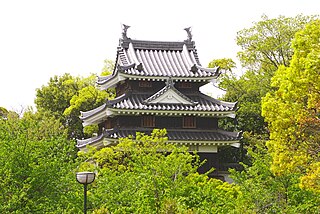
Nishio Domain was a feudal domain of the Tokugawa shogunate of Edo period Japan, located in former Mikawa Province, in what is now the modern-day city of Nishio in Aichi Prefecture, Japan. It was centered on Nishio Castle.

Chiryū-juku was the thirty-ninth of the fifty-three stations of the Tōkaidō. It is located in the present-day city of Chiryū in Aichi Prefecture, Japan. It was the westernmost post town in Mikawa Province, and was 330 kilometres (210 mi) from Nihonbashi, the start of the Tōkaidō, so it took approximately 10 days to for average travellers to reach.
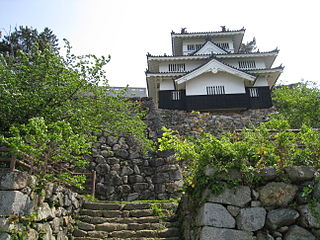
Yoshida Domain was a Japanese feudal domain under the Tokugawa shogunate of Edo period Japan, located in Mikawa Province located in eastern Mikawa Province, Japan. It was centered on Yoshida Castle in what is now the city of Toyohashi, Aichi. It was ruled by a number of different fudai daimyō over the course of the Edo period, before finally passing into the hands of the Matsudaira (Ōkōchi) clan. Just before its dissolution it was renamed, and it became the Toyohashi Domain.

Minakuchi-juku was the fiftieth of the fifty-three stations of the Tōkaidō highway connecting Edo with Kyoto in Edo period Japan. It was located in the Minakuchi neighborhood of the present-day city of Kōka, Shiga Prefecture, Japan.

Kameyama-juku was the forty-sixth of the fifty-three stations (shukuba) of the Tōkaidō connecting Edo with Kyoto in Edo period Japan. It was located in former Ise Province in what is now the center of the city of Kameyama, Mie Prefecture, Japan.

Kariya Domain was a feudal domain of the Edo period Tokugawa shogunate located in Mikawa Province, Japan, what is now part of the modern-day cities of Kariya and Anjō. It was centered on Kariya Castle, which was located in what is now the city of Kariya.

Tahara Castle is a Japanese castle located in Tahara, southern Aichi Prefecture, Japan. At the end of the Edo period, Tahara Castle was home to the Miyake clan, daimyō of the 12,000 koku Tahara Domain.
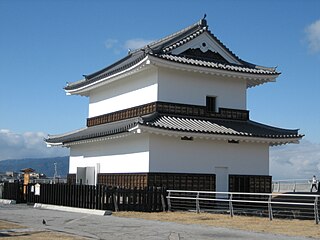
Kuwana Castle is a Japanese castle located in Kuwana, northern Mie Prefecture, Japan. At the end of the Edo period, Kuwana Castle was home to a branch the Matsudaira clan, daimyō of Kuwana Domain. The castle was also known as "Ōgi-jō" (扇城) or "Asahi-jō" (旭城).
Kamehime was the eldest daughter of Tokugawa Ieyasu, the founder and first shogun of the Tokugawa Shogunate of Japan, with his first wife, Lady Tsukiyama. She was the wife of Okudaira Nobumasa. She is primarily recognized as the eldest offspring of Ieyasu, notable for her active participation in the Siege of Nagashino and her significant role in the events leading to the downfall of Honda Masazumi.






















